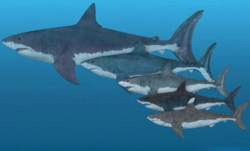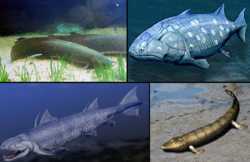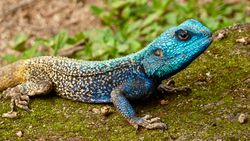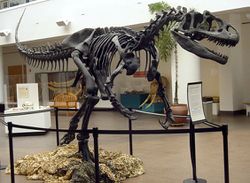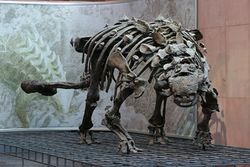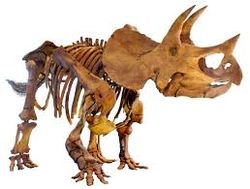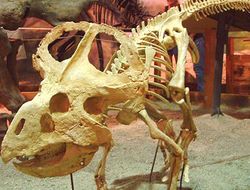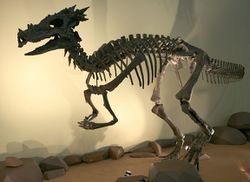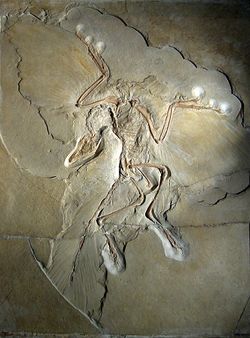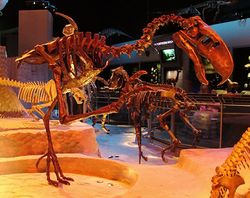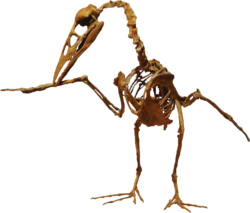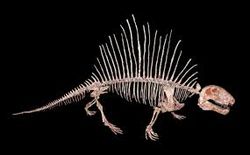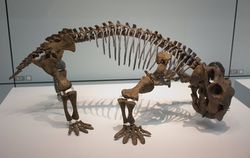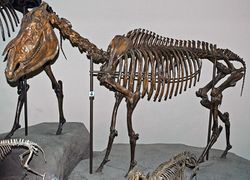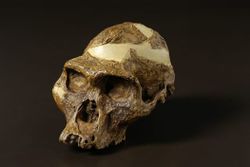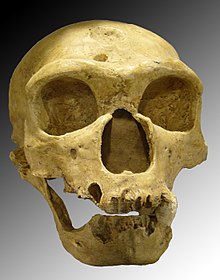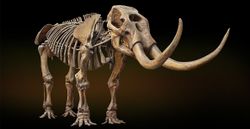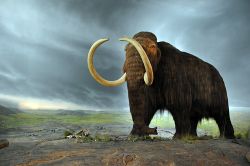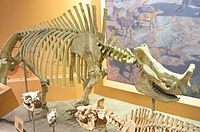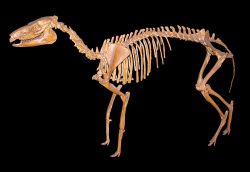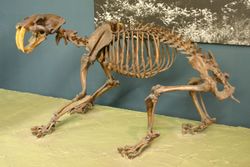Fossils/Vertebrates
- Main article: Fossils
This page is incomplete. |
Subphylum Vertebrata
| Picture(s) | No pictures have been added as of yet. |
|---|---|
| Physical Description | Have a backbone and cranium. |
| Fossil Range | Evolved during the Cambrian Explosion. |
| Taxonomy | Kingdom: Animalia Phylum: Chordata |
| Adaptations Over Time | Slowly became bigger and more terrestrial. They evolved bigger jaws and stronger bones. |
Superclass Agnatha (Jawless Fish) (Ostracoderms)
This fossil will only be tested at the State and National levels.
| Picture(s) | 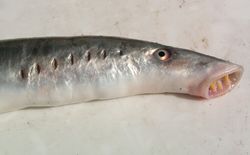
|
|---|---|
| Common Names | Jawless fish, including lampreys and hagfish. |
| Physical Description | They lack paired appendages and jaws. They have skin but no dermal or epidermal scales. Instead of stomachs, they simply have one long gut. Cold-blooded (ectothermic). Two-chambered heart. They have seven or more paired gill pouches. Possess a notochord (a cartilage-like rod that is a characteristic feature of all chordates in at least one stage of life) during their larval and adult stages. They possess a photoreceptive parietal eye for regulating circadian rhythm and body heat. The skeleton is made of cartilage. |
| Fossil Range | Cambrian Explosion to present-day. |
| Taxonomy | Agnatha is split up into Cyclostomata (extant and comprising lampreys and hagfish, ~120 species), Conodonta (extinct), and Ostracoderms (extinct). Sister taxon to Gnathostomata (jawed vertebrates). rRNA and mtDNA data suggest that Cyclostomata is monophyletic. |
| Mode of Life or Habitat | Cold marine waters from 10 meters deep at high latitudes to 1300 meters at low altitudes. Lampreys feed on other fish and mammals. Hagfish are scavengers. No known parental care, fertilization is most likely external. |
| Distribution | Worldwide, except for tropics and polar regions. |
| Etymology | Ancient Greek for "without jaws." |
| External Links | https://en.wikipedia.org/wiki/Notochord. https://en.wikipedia.org/wiki/Agnatha. https://en.wikipedia.org/wiki/Parietal_eye. |
Class Placodermi (Armored Jawed Fish)
| Picture(s) | 
|
|---|---|
| Common Names | Placoderms |
| Physical Description | Most were small fish reaching lengths of 15 cm; however, a few species reached lengths of 4 to 10 meters. They all have jaws, an internal skeleton, head and trunk armor, paired fins, and projecting spines to the sides of the trunk shield. A neck joint allowed them to lift the anterior portion of their head shield. The head and thorax are covered by armored, bony plates. The rest of the body is either covered in small plates or has no plates. The bony plates have three layers, a basal layer made of compact bone, a middle layer made of spongy bone, and a superficial layer. |
| Fossil Range | Early Silurian (in China) to the Late Devonian (“Age of Fish”). They became extinct at the end-Devonian Hangenberg event. |
| Taxonomy | Infraphylum: Gnathostomata. Thought to be paraphyletic, consisting of sister groups to modern jawed vertebrates. However, they could be monophyletic. First studied by Louis Agassiz, 1833-1843. |
| Mode of Life or Habitat | Placoderms lived in both marine and freshwater environments. They were predators and some may have been filter feeders. |
| Adaptations Over Time | One of the first fish that developed jaws. They evolved jaws from their gill arches. Instead of teeth, they had bony plates. First fish to develop paired pelvic fins, which would later develop into hindlimbs. First fish to develop true teeth. Some genera in this class exhibit the oldest known examples of live birth. |
| Distribution | Worldwide distribution by the Devonian. |
| Etymology | Comes from the Greek for plate-skinned or tablet-skinned. |
| External Links | https://en.wikipedia.org/wiki/Bothriolepis. https://en.wikipedia.org/wiki/Placodermi. https://onlinelibrary.wiley.com/doi/full/10.1111/pala.12093. |
Genus Bothriolepis
| Picture(s) | 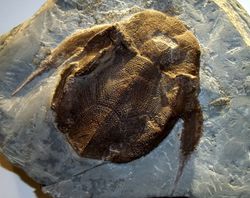
|
|---|---|
| Physical Description | Around 30 cm long, but the largest species (B. rex) could be 170 cm long. Lifted their bodies with pectoral fins. Bothriolepis also could have used its fins to throw sediment over itself. Had heavily armored heads attached to the thoracic shield and two holes on their heads (one on the upper side for the eyes and nose and one on the lower side for the mouth), along with preorbital recesses (separate bones below the eyes and noses). The thoracic shield covered almost half of their body. In addition to its gills, they had pouches that connected to the oesophagus, which may have been rudimentary lungs that may have allowed them to live for short periods out of the water. The two halves of the jaw are separate, and adults can use them independently of one another. The tail (caudal fin) was long and is rarely preserved due to its soft nature. |
| Fossil Range | (Middle and) Late Devonian, ~387-360 mya. |
| Taxonomy | Order: Antiarchi Family: Bothriolepididae |
| Mode of Life or Habitat | Benthic detritus feeders. Found in both shore marine and freshwater. Likely to have spent most of its life in freshwater but probably entered saltwater at times. |
| Distribution | Widespread and abundant. Worldwide, in every paleo-continent. |
| Etymology | Means pitted scale or trench scale in Greek. |
| Additional Information | Bothriolepis is a diverse genus. |
| External Links | https://en.wikipedia.org/wiki/Bothriolepis. |
Genus Dunkleosteus
| Picture(s) | 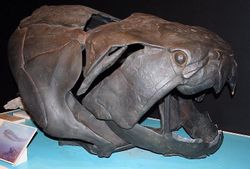
|
|---|---|
| Physical Description | Some of the largest placoderms. Largest species could grow up to 8.79 m long. Could open and close jaws very quickly, with a bite force of 6000 N. Could weigh up to 4 tons. Instead of teeth, they had 2 pairs of sharp plates which formed a beak. Juveniles likely also had large bite forces. |
| Fossil Range | Late Devonian, 382-352 mya. It became extinct in the Hangenberg event. |
| Taxonomy | Order: Arthrodira Family: Dunkleosteidae |
| Mode of Life or Habitat | Hypercarnivorous apex predators. Diet could have included armored prey such as ammonites and other placoderms. Sometimes cannibalized. May have been pelagic. They were slow swimmers so they ambushed their prey to hunt. Lived in shallow waters as juveniles, then moved to deeper waters. Speed of jaw opening and closing is consistent with suction feeding, where prey is sucked into the predator's mouth. |
| Adaptations Over Time | May have been among the first vertebrates to internalize egg fertilization. |
| Distribution | Many fossils have been found in North America, Belgium, Morocco, and Poland. |
| Etymology | Named in 1956 after David Dunkle, a paleontologist at the Cleveland Museum of Natural History. ὀστέον, "osteon" is Greek for bone. |
| Additional Information | Only about 5% of specimens have more than a quarter of the skeleton preserved. Specimens often found with boluses (balled up mix of food and saliva) of fish bones, may have regurgitated bones instead of digesting them. |
| External Links | https://en.wikipedia.org/wiki/Dunkleosteus. |
Class Chondrichthyes (Cartilaginous Fish)
| Picture(s) | 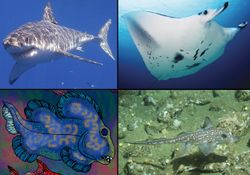
|
|---|---|
| Common Names | Cartilaginous fish. |
| Physical Description | Have skeletons made of cartilage with tough skins covered in sharp tooth-like scales (dermal denticles or placoid scales) which are all oriented in one direction. Electric rays are the exception: they have flabby bodies. Chondrichthyans have paired fins and paired nostrils. Their hearts have two chambers in series. The notochord is replaced by vertebrae. They lack bone marrow: red blood cells are created in the spleen and epigonal organ. Some sharks and rays have Leydig's organs which also produce red blood cells. They have five to seven pairs of gills. Sharks, skates, and rays have special electrosensory organs known as ampullae of Lorenzini. Some species have two dorsal (back) fins while some have one dorsal fin. The pectoral (side) fins are used for steering. The pelvic fin is found on the stomach and stabilizes the body. The clasper is an organ in males found near the pelvic fin used for mating. The tail is called the caudal fin and gives propulsion. It is heterocercal, meaning the upper lobe is bigger than the lower lobe and contains part of the vertebral column. The anal fin, if present, is also used for stabilization. |
| Fossil Range | Late Silurian to recent. |
| Taxonomy | Infraphylum: Gnathostomata. Split into two subclasses: Elasmobranchii (sharks, rays, skates, and sawfish) and Holocephali (chimaeras/ghost sharks). |
| Mode of Life or Habitat | Can be pelagic (in which case they must keep swimming to get water through their gills) or demersal (in which case they can pump water in through the spiracles behind their eyes and out through their gills). Due to their lack of a swim bladder, pelagic species must continuously swim to avoid sinking (buoyancy is given by large amounts of liver oil). Most are marine. Only 5% are restricted to freshwater (e.g. the freshwater stingray). Half of the species live down to depths of 200 m (on the continental slope) while 35% live in depths of 200-2000 m. Beyond that, high salinity and low oxygen levels pose as barriers. Only 5% swim through the open ocean (e.g. the great white shark). Some give birth to eggs surrounded by egg cases/capsules while others give live birth. Predators. |
| Adaptations Over Time | Among the first vertebrates to evolve jaws and bony teeth. Evolved from spiny sharks (Acanthodii). Very diverse group. |
| Distribution | Waters worldwide. |
| Etymology | From Greek "cartilage fish," χονδρ chondr "cartilage" + ἰχθύς ichthys "fish." |
| External Links | https://en.wikipedia.org/wiki/Chondrichthyes. https://www.ucl.ac.uk/museums-static/obl4he/vertebratediversity/chondrichthyes.html. https://nhpbs.org/wild/chondrichthyes.asp. http://www.comfsm.fm/~brianl/chondrichthyes.html. |
Superorder Selachimorpha (Sharks)
| Picture(s) | 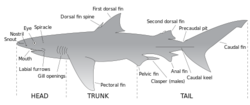
|
|---|---|
| Common Names | Sharks |
| Physical Description | Usually streamlined body. The jaws are not attached to the cranium. They shed and replace their teeth and scales. The teeth are made of calcium phosphate, an apatite. The pectoral fin is not fused to the head. Can range from 17 cm (the pygmy shark) to 12 m (the whale shark). |
| Fossil Range | Late Silurian to modern-day, 425- mya. |
| Taxonomy | Subclass: Elasmobranchii |
| Mode of Life or Habitat | Common to depths of 2000 m. Usually do not dwell in freshwater, although some do (bull shark and river shark can be found in freshwater and seawater). Well-known species are apex predators. Poikilotherms, "cold-blooded." Most live 20 to 30 years. Sharks practice internal fertilization. |
| Adaptations Over Time | Sharks have a hydrodynamic shape in order to swim with less resistance, with tapered ends at the head and tail. Most sharks are dark with pale bellies, with camouflages them from above and below. |
| Distribution | Waters worldwide. |
| Etymology | The origin of the word "shark" is uncertain. |
| Additional Information | Some have biofluorescence. Some species can detect as little as 1 ppm of blood in seawater. |
| External Links | https://en.wikipedia.org/wiki/Shark. |
Genus Otodus
| Picture(s) | 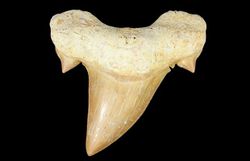
|
|---|---|
| Common Names | A type of mackerel shark (all sharks in Lamniformes are mackerel sharks). |
| Physical Description | The teeth could get to 10.4 cm tall, and the vertebral centrum could get over 12.7 cm wide. Thus, the maximum length of the shark is estimated to be between 9.1 and 12.2 meters long. The teeth have a triangular crown and smooth cutting edges with visible cusps on the roots. |
| Fossil Range | Paleocene to Pleistocene (66-0.34 mya). |
| Taxonomy | Order: Lamniformes Family: Otodontidae. |
| Mode of Life or Habitat | Top predator. Likely preyed on large bony fish, aquatic mammals, and other sharks. |
| Adaptations Over Time | Transitional teeth show Otodus evolving into Carcharocles. These teeth have lightly serrated cusplets and serrated cutting edges and are found all over the world (Maryland, Belgium, and Kazakhstan), implying that the evolution occurred worldwide. The ancestor of Carcharocles is thought to be O. aksuaticus. |
| Distribution | Worldwide. |
| Etymology | Ancient Greek ὠτ (ōt, "ear") and ὀδούς (odoús, "tooth"), combining to make "ear-shaped tooth." |
| Additional Information | Fossilized parts are teeth and vertebrae. |
| External Links | http://fossilworks.org/bridge.pl?a=taxonInfo&taxon_no=34621. https://en.wikipedia.org/wiki/Otodus. |
Genus Carcharocles
Species C. megalodon
| Picture(s) | 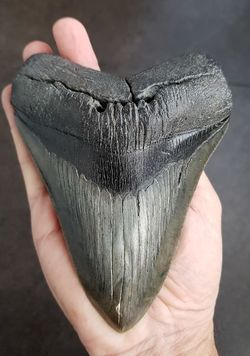
|
|---|---|
| Common Names | Megalodon |
| Physical Description | Around 10.5 m long on average and up to 16 m. Their jaws could exert forces of up to 180000 N. Large, triangular teeth with serrations and a V-shaped neck. In 1926, a partial vertebral column was found in Belgium made up of 150 vertebral centra. The centra were 5.5-15.5 cm in diameter. May have looked similar to a great white shark. Its skeleton was heavily calcified. They had about 276 teeth in 5 rows. |
| Fossil Range | Late Oligocene to late Pliocene, ~28-2.6 mya. |
| Taxonomy | Agassiz assigned the species to Carcharodon (great white sharks) in 1843. Another genus that the megalodon is commonly designated under is Otodus. |
| Mode of Life or Habitat | Adults were not abundant in shallow water environments, and mostly lurked offshore. They gave birth to their young in shallow water environments. Top predator. Probably ate large animals such as whales, seals, and sea turtles. |
| Distribution | Worldwide. Teeth have been found in the Mariana Trench. |
| Etymology | Megalodon means "big tooth" in Greek. |
| Additional Information | Went extinct from numerous different factors including the cooling of the ocean, sea level drops, and habitat loss due to the Ice Age, as well as competition from whale-eating whales for food. After the megalodon went extinct, baleen whales became significantly larger. In the Renaissance, megalodon teeth were thought to be the tongues of dragons and snakes and were called glossopetrae. |
| External Links | https://en.wikipedia.org/wiki/Megalodon. |
Superorder Batoidea (Rays)
This fossil will only be tested at the State and National levels.
| Picture(s) | 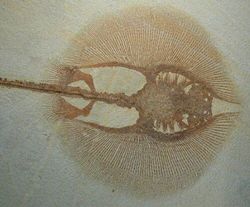
|
|---|---|
| Common Names | Rays and skates |
| Physical Description | Flat bodies made of a tough, elastic material. Disk-like bodies. Rays and skates always have spiracles, unlike sharks, which are holes behind the eyes that allow oxygen into the body. The eyes are on the top of the head, unlike sharks which have eyes on the sides. The pectoral fins are not distinct, whereas sharks have distinct pectoral fins. Rays and skates swim by flapping their pectoral fins like wings. The tails are whip-like, and the gills are under the body (five gill openings). They have heavy, rounded teeth for crushing the shells of prey. Some rays may have tails that contain venom. The flat body combines with the color of the top of the body to allow the ray to camouflage in the sand, waiting overhead for prey. |
| Fossil Range | Early Triassic to present-day. |
| Taxonomy | Subclass: Elasmobranchii Contains more than 500 species, and 13 families. |
| Mode of Life or Habitat | Usually live on the seafloor in coastal waters. Mostly docile and slow-moving. Varied diets: they eat mostly fishes and invertebrates. Some eat plankton and other small organisms. Rays exhibit internal fertilization, giving birth to live young. Skates give birth to egg cases, which have been called "mermaid's purses." |
| Distribution | Worldwide. They prefer tropical and subtropical waters. |
| Etymology | Named after Batis, a genus of sparrow-like birds. |
| External Links | https://en.wikipedia.org/wiki/Batoidea. https://en.wiktionary.org/wiki/Batoidea. |
Superclass Osteichthyes (Bony Fish)
| Picture(s) | No pictures have been added as of yet. |
|---|---|
| Common Names | Bony fish |
| Physical Description | Fish with bone skeletons. They usually have overlapping scales and three pairs of gills. A series of bones called the operculum covers the gills and supports the face. The fin spines and rays are called lepidotrichia. Bony fish usually have swim bladders, which allow them to keep their place in the water without using their fins. One notable group of fish that do not possess swim bladders are lungfish. |
| Fossil Range | Evolved in the Late Silurian. |
| Taxonomy | Infraphylum: Gnathostomata The taxon is paraphyletic: it does not include land vertebrates, which evolved from fish. |
| Mode of Life or Habitat | Found in both marine and freshwater environments. |
| Adaptations Over Time | Possibly evolved from early placoderms. Grew better at foraging and locomotion as time passed. |
| Distribution | Worldwide. |
| Etymology | The name is Ancient Greek for "bone fish," ὀστέον (ostéon, "bone") + ἰχθῡ́ς (ikhthū́s, "fish"). |
| Additional Information | Largest class/superclass of vertebrates extant today. |
| External Links | https://en.wiktionary.org/wiki/Osteichthyes. https://en.wikipedia.org/wiki/Osteichthyes. https://en.wikipedia.org/wiki/Evolution_of_fish. |
Class Actinopterygii (ray-finned)
| Picture(s) | 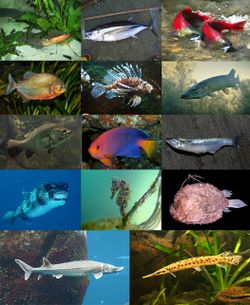
|
|---|---|
| Common Names | Ray-finned fish |
| Physical Description | Ray-finned fish are fish that have fins with webs of skin supported by bony/horny spines (called rays). They range from less than a centimeter long to around 12 meters. |
| Fossil Range | Evolved during Late Silurian. The earliest known ray-finned fish was Andreolepis hedei, dating back 420 mya, found in Russia, Sweden, and Estonia. |
| Mode of Life or Habitat | Seawater and freshwater at all depths. Most use external fertilization, with the female laying the eggs and then the male inseminating them. They feed on algae, diatoms, insects, and smaller fish. |
| Adaptations Over Time | The swim bladder evolved into a more efficient organ in the teleost making them neutrally buoyant. |
| Distribution | Worldwide. |
| Etymology | New Latin actino- (possessing rays) + Ancient Greek πτέρυξ (ptérux, "fins"). |
| Additional Information | 99% of the over 30,000 species of fish extant. Largest class of vertebrates extant today. |
| External Links | https://en.wikipedia.org/wiki/Actinopterygii. https://en.wiktionary.org/wiki/Actinopterygii. |
Genus Knightia
| Picture(s) | 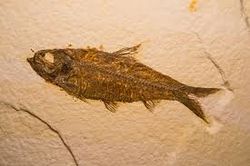
|
|---|---|
| Physical Description | Resembles herrings. The size ranges from 6 cm to 15 cm, with some growing up to 25 cm (K. eocaena). Heavy scales and small, conical teeth. |
| Fossil Range | (Late Cretaceous? to) Early Eocene, ~84-23.03 mya. |
| Taxonomy | Order: Clupeiformes Family: Clupeidae Subfamily: Pellonulinae |
| Mode of Life or Habitat | Freshwater lakes and rivers. Probably fed on algae and diatoms, and possibly insects and smaller fish. They traveled in large schools and so were a bountiful food source for predators. |
| Distribution | North America and Asia |
| Etymology | Named by David Starr Jordan in 1907 in honor of Wilbur Clinton Knight, a professor at the University of Wyoming. |
| Additional Information | Knightia is the state fossil of Wyoming. It is the most commonly excavated fossil fish worldwide. Knightia is abundant in Wyoming's Green River Formation, and is often found being preyed on by larger fish fossils. |
| External Links | https://en.wikipedia.org/wiki/Knightia. http://fossilworks.org/bridge.pl?a=taxonInfo&taxon_no=35455. |
Genus Xiphactinus
This fossil will only be tested at the State and National levels.
| Picture(s) | 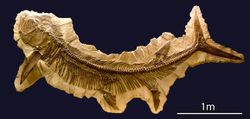
|
|---|---|
| Common Names | X-fish. Bulldog fish. |
| Physical Description | Approximately 5.1 m long with fangs and a distinctive underbite. It was the largest bony fish of the Cretaceous. The tail is forked, and attached to a narrow base. The jaw is very mobile, and therefore able to take in large prey. Its body is slender. |
| Fossil Range | Cretaceous, ~112-66 mya. They died out during the Cretaceous-Paleogene extinction. |
| Taxonomy | Order: Ichthyodectiformes Family: Ichthyodectidae Subfamily: Ichthyodectinae |
| Mode of Life or Habitat | Shallow and deep marine. Very predatory, consuming fish, seabirds, and maybe pterosaurs. It was common for a dead or bleeding Xiphactinus fish to be eaten by sharks. |
| Distribution | Kansas, the US east coast, Europe, Australia, Canada, Venezuela, and Argentina. During the Cretaceous, the American midwest was submerged under the Western Interior Sea. |
| Etymology | Greek xiphos meaning sword + New Latin actino meaning ray. |
| Additional Information | State fossil of Kansas. Often found with undigested/partially digested prey inside their stomachs. We do not know much about the larval and juvenile phrases of their life cycle. Republican Representative of Kansas Tom Sloan proposed that Xiphactinus be the Kansan state fossil in 2010, but it did not happen. |
| External Links | https://en.wikipedia.org/wiki/Xiphactinus. https://www.thoughtco.com/history-of-xiphactinus-1093712. https://blog.everythingdinosaur.co.uk/blog/_archives/2010/08/22/4610992.html. |
Class Sarcopterygii (lobe-finned)
Genus Eusthenopteron
| Picture(s) | 
|
|---|---|
| Physical Description | They were 5-6 feet long, and covered in scaly skin. Eusthenopteron had internal nostrils (called choanae), like tetrapods, as well as tetrapod-like teeth with enamel and a two-part cranium. The lepidotrichia cover all of its fins, and its fore-fin and pelvic fin endoskeletons resemble arms and legs respectively. |
| Fossil Range | Late Devonian, 383.7-376.1 mya. |
| Taxonomy | Clade: Tetrapodomorpha Clade: Eotetrapodiformes Family: Tristichopteridae First described in 1881 by J. F. Whiteaves. |
| Mode of Life or Habitat | They lived in shallow waterways, and preyed on smaller fish. Strictly aquatic, although it has a close relationship to tetrapods that made it onto land. Previously thought to have been one of the aquatic animals that started to make its way onto land. No larval stage has been found with evidence that it metamorphosizes into the adult Eusthenopteron, suggesting that it might hatch as an adult form. |
| Adaptations Over Time | They have a close relationship to tetrapods. Earliest animal known to have bone marrow. |
| Distribution | Quebec (Shore of River Ristigouche, Miguasha) |
| Etymology | Greek: eustheno ("strength") + pteron ("wing"), possibly combining to form strongly developed fins. |
| External Links | https://en.wikipedia.org/wiki/Eusthenopteron. https://www.wired.com/2012/05/a-new-twist-in-the-tetrapod-tale/. http://fossilworks.org/bridge.pl?a=taxonInfo&taxon_no=34918. |
Genus Latimeria (Coelacanth)
| Picture(s) | 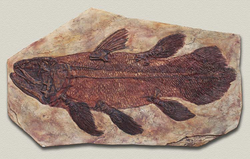
|
|---|---|
| Common Names | A genus of coelacanth. There are two extant species: the West Indian Ocean coelacanth (L. chalumnae) and the Indonesian coelacanth (L. menadoensis). In Indonesia, the Indonesian coelacanth is known as raja laut, king of the sea. In South Africa, Latimeria was termed gombessa or mame. |
| Physical Description | They are approximately 2 m long and weigh 80 kg. Like all coelacanths, they have a three-lobed tail with the spinal column extending to the end of the tail (diphycercal). The West Indian Ocean coelacanth is deep blue while the Indonesian coelacanth is brown. |
| Fossil Range | Middle Pleistocene (0.02 mya) to present-day. |
| Taxonomy | Subclass: Actinistia Order: Coelacanthiformes Family Latimeriidae |
| Mode of Life or Habitat | They are found in deep reefs and volcanic slopes in both freshwater and marine environments. They eat cuttlefish, squid, snipe eels, small sharks, and other fish. They give birth to live young (pups). |
| Adaptations Over Time | One of the slowest evolving genomes of all known vertebrates. They are able to control the speed of their metabolism, achieving hibernation-like effects. Coelacanths can swim backwards and belly up in order to catch prey. Their eyes are very sensitive, which is why they are almost never found in daylight or well-lit water. Their eyes have an abundance of rods to detect objects in low light and a layer of tissue called the tapetum lucidum which helps night vision. |
| Distribution | Indian Ocean (critically endangered) and Indonesia (vulnerable). The water must be cold and well-oxygenated. Usually live in depths of 90-200 m but can be found as deep as 700 m. |
| Etymology | Coelacanth comes from Greek koilos ("hollow") + akantha ("spine"), referring to their unique hollow spine fins. |
| Additional Information | Coelacanths are living fossils and were once thought to be extinct in the Late Cretaceous. As a whole, coelacanths are now extremely rare. Growth rings in the ears (calcium carbonate otoliths) indicate that they can live up to 80 to 100 years. |
| External Links | https://en.wikipedia.org/wiki/Latimeria. https://en.wikipedia.org/wiki/West_Indian_Ocean_coelacanth. https://en.wikipedia.org/wiki/Indonesian_coelacanth. |
Genus Tiktaalik
| Picture(s) | 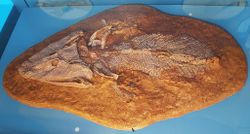
|
|---|---|
| Common Names | Some people call Tiktaalik a "fishapod." |
| Physical Description | 3 to 9 feet long. The eyes were on the top of the skull, rather than the sides. The shoulders were not connected to the skull, so it had a functional neck. They had "arms," including a shoulder, elbow, and wrist. Their skeletons could support their bodies. |
| Fossil Range | Late Devonian, 383.7-376.1 mya. |
| Taxonomy | Clade: Tetrapodomorpha Clade: Eotetrapodiformes Clade: Elpistostegalia Clade: Stegocephalia There is only one species: T. roseae. |
| Mode of Life or Habitat | Lived in estuaries and deltas. They ate smaller fish and bug-like creatures. It is unlikely that they could live entirely on land. However, it is likely that they could cross dry land. |
| Adaptations Over Time | They are an important transition fossil between fish and tetrapods. |
| Distribution | Found in Bird Fiord, in Nunavut, Canada. |
| Etymology | "Tiktaalik" is Inuktitut for "large freshwater fish." |
| External Links | https://en.wikipedia.org/wiki/Tiktaalik. http://fossilworks.org/bridge.pl?a=taxonInfo&taxon_no=77132. |
Class Amphibia (Amphibians)
| Picture(s) | 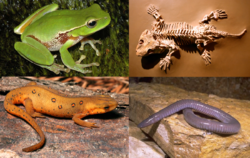
|
|---|---|
| Common Names | Amphibians |
| Physical Description | Changes in anatomy allowed the upper body to be propped up for breathing, the head to turn, and created a rigid structure strong enough to support walking. Their eyes are larger than their predecessors because eyesight is more important on land than in water. They can weigh up to 500 pounds. |
| Fossil Range | Evolved during the Late Devonian. Lost relevance to reptiles during the Carboniferous rainforest collapse and were hurt during the Permian-Triassic extinction. |
| Taxonomy | Superclass: Tetrapoda |
| Mode of Life or Habitat | Most undergo metamorphosis where the larva's gills are replaced by lungs. Amphibians need water bodies in order to reproduce. They are usually not found in the sea and live in moist habitats on land. Most amphibians are predators, eating almost anything that is swallowable and moves. |
| Adaptations Over Time | They may have moved to land because of seasonal droughts and escape from drying pools, or maybe because they were carnivores and the land had a lot of arthropods which they could eat. |
| Distribution | All continents except Antarctica. |
| Etymology | "Amphibia" means "double life" and refers to a life cycle that includes an aquatic existence and a terrestrial existence. |
| External Links | https://en.wikipedia.org/wiki/Amphibian. |
Genus Acanthostega
| Picture(s) | 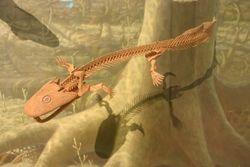
|
|---|---|
| Physical Description | One of the first vertebrates to have recognizable limbs. They had eight digits on each hand linked by webbing. They lacked wrists and were generally unfit to come on land. They had both lungs and gills. About 0.7 m long and 10-20 kg. They had stubby legs. It had fish-like teeth and a lateral line organ (a system of epithelial cells, or hair cells, that detect movement in nearby water). |
| Fossil Range | Late Devonian, 365 mya. |
| Taxonomy | Clade: Tetrapodomorpha Clade: Eotetrapodiformes Clade: Elpistostegalia Clade: Stegocephalia |
| Mode of Life or Habitat | Rivers and shallow, weed-choked swamps. Probably ate fish. May have spent most of its time in shallow water. |
| Adaptations Over Time | In general, they were poorly adapted for going on land (for example, joints were not very mobile, shoulder and forearm were very fish-like, ribs were too short to support the chest out of water). The eight digits on each hand perhaps indicates that Acanthostega may have been an evolutionary dead end. |
| Distribution | Northern latitudes. |
| Etymology | From Ancient Greek ᾰ̓́κᾰνθᾰ ákantha (“thorn” or “spine”) + στεγανός steganós (“roof”), combining to form “spiny roof” |
| Additional Information | A famous fossil was found by Jennifer A. Clark in East Greenland in 1987, though fragments of the skull had been found in 1993 by Erik Jarvik and Gunnar Säve-Söderbergh. |
| External Links | https://en.wikipedia.org/wiki/Acanthostega. https://www.thoughtco.com/overview-of-acanthostega-1093636. https://en.wikipedia.org/wiki/Lateral_line. |
Genus Eryops
| Picture(s) | 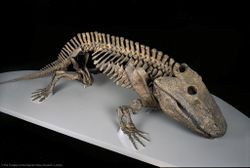
|
|---|---|
| Physical Description | 1.5-2 m long but could grow up to 3 m. One of the largest land animals of its time. Adults were around 90 kg. Stout body with very wide ribs, a strong spine, four short and strong legs, a short tail, and a wide and elongated skull with many sharp teeth and strong jaws. Their skulls were broad and flat (2.0 feet or 60 cm long). Eryops had an unusually large skull and mouth with many curved teeth, with enamel in a folded pattern. The limbs were long and strong. The shoulder girdle is disconnected from the skull for improved terrestrial locomotion. |
| Fossil Range | Late Carboniferous to Early Permian, 299-278 mya. |
| Taxonomy | Order: Temnospondyli Family: Eryopidae Thought to have one species, E. megacephalus. |
| Mode of Life or Habitat | Probably had similar hunting behavior to crocodiles, eating large fish and aquatic tetrapods. Habitat was lowland habitats in and around ponds, streams, rivers, and lakes. Juveniles probably lived in swamps which gave them protection from predators, while adults spent most of their time on land, although there was no sudden metamorphosis like with modern amphibians, instead slowly transitioning from aquatic larvae. |
| Distribution | North America and western Europe. Mostly Texas (Permian) and New Mexico (Carboniferous). |
| Etymology | Ancient Greek ἐρύειν, eryein (“drawn-out”) + ὤψ, ops (“face”) since most of its face is in front of its eyes. |
| Additional Information | Skull and teeth are most common fossils, but several complete skeletons have been found. |
| External Links | https://en.wikipedia.org/wiki/Eryops. |
Genus Diplocaulus
| Picture(s) | 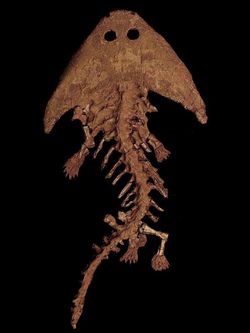
|
|---|---|
| Physical Description | The skull is shaped like a boomerang, possibly serving as a hydrofoil (helping Diplocaulus glide through the water) or as a defense mechanism. The bodies were stocky and salamander-like and reached 1 meter long, making them relatively large land animals for the time. They likely swam with an up and down movement like dolphins. Skulls are up to 40 centimeters wide across the horn tips. Their mouth gape was very small because the lower jaw hinge was posterior to the eye sockets. Diplocaulus is thought to have a long, thin tail that could curl up to reach the head, as in one fossil described in 1917, there were tail vertebrae next to the head. As a result, Diplocaulus is thought to have used anguilliform (eel-like) tail movement to propel itself. |
| Fossil Range | Late Carboniferous to Late Permian, 306-255 mya. |
| Taxonomy | Subclass: Lepospondyli Order: Nectridea Family: Diplocaulidae. |
| Mode of Life or Habitat | Lived in rivers, lakes, and swamps. They ate insects and fish. |
| Adaptations Over Time | Their head shape could have been defensive because predators would have a hard time trying to swallow such a large head. |
| Distribution | North America and North Africa. |
| Etymology | The name means "double caul" (the caul is the piece of membrane that covers a newborn's head and face. |
| External Links | https://en.wikipedia.org/wiki/Diplocaulus. |
Class Reptilia (Reptiles)
Order Crocodilia (crocodiles)
This fossil will only be tested at the State and National levels.
| Picture(s) | 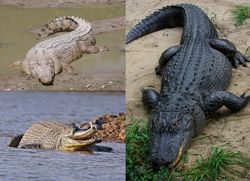
|
|---|
Order Testudines (turtles)
This fossil will only be tested at the State and National levels.
| Picture(s) | 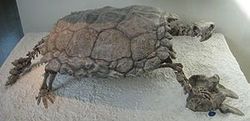
|
|---|
Order Icthyosauria (Ichthyosaurs)
| Picture(s) | 
|
|---|---|
| Common Names | Ichthyosaurs |
| Physical Description | Eel-like, 1-16+ m long although they averaged 2-4 m. They had big eyes, the largest eyes of any reptile discovered. These large eyes support the hypothesis that ichthyosaurs underwent deep diving, since large eyes would have been useful for being able to see on deep dives. Later species were more dolphin-like (convergent evolution) than eel-like. Ichthyosaurs had elongated skulls and conical teeth, made of enamel and dentin, although teeth could also have cutting edges or crowns, depending on the species and its diet, e.g. shellfish-eaters versus fish-eaters. Many ichthyosaurs were heterodonts, with different tooth shapes in different parts of the mouth. Buoyant. Could swim up to 25 mph, making them perhaps one of the fastest marine reptiles to exist. The number of fingers varies by species, from two to up to ten per hand. The pelvis is loose, with the ilium, ischium, and pubic bone disconnected from each other. Possibly contained blubber (as evidenced by the 2018 discovery of Stenopterygius). |
| Fossil Range | Early Triassic to Late Cretaceous, 250-90 mya. Most abundant in late Triassic and early Jurassic. Afterwards they were displaced by competition with plesiosaurs. Died out from the Cenomanian-Turonian anoxic event, which disturbed the oxygen and sulfur cycles in the ocean, as well as the carbon cycle, possibly from undersea volcanoes. |
| Taxonomy | Subclass: Diapsida. Although they were once thought to be amphibians, it is now agreed that they are reptiles and that they descended from terrestrial tetrapods. |
| Mode of Life or Habitat | Carnivores. Wide range of prey, with different species having different diets, ranging from fish to cephalopods to birds to even smaller ichthyosaurs. Some ichthyosaurs crushed their prey with flat teeth, while others may have been suction feeders or used other methods. Ichthyosaurs gave birth to live young (i.e. they were viviparous), unlike terrestrial reptiles. Their sight was their most important sense: their hearing could have been poor. Ichthyosaurs may also have had electroreception capabilities. Ichthyosaurs were eaten by sharks and other ichthyosaurs, then by plesiosaurs and crocodilians after they evolved. It is thought that despite being a reptile, ichthyosaurs were warm-blooded (endothermic). |
| Adaptations Over Time | Earlier species swam by moving their whole body from side to side (anguilliform motion), but later species swam moving only their tails (carangiform or possibly thunniform motion). Later species had paddle-shaped fins in place of forelimbs and hindlimbs (analogous structures with dolphin fins, although ichthyosaurs are not closely related to dolphins). |
| Distribution | All Mesozoic oceans. Found in Europe, North America, South America, and Asia. |
| Etymology | Ichthyosauria means "fish lizard." Named in 1821 by William Daniel Conybeare and Henry de la Beche. |
| Additional Information | Hundreds of specimens recovered. Skin impressions through bacterial mats reveal the dorsal and caudal fins (which are not usually preserved). Many well-preserved fossils in Germany. One genus of ichthyosaur was found in the Solnhofen Limestone in Germany and seemed to show impressions of scales. Coprolites are common. Gastroliths are also sometimes found and may have helped with regulating buoyancy or digestion. It is debated whether ichthyosaurs had dorsal fins. |
| External Links | https://en.wikipedia.org/wiki/Ichthyosaur. |
Order Squamata
| Picture(s) | No pictures have been added as of yet. |
|---|
Family Mosasauridae (Mosasaurs)
| Picture(s) | 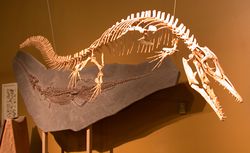
|
|---|---|
| Common Names | Mosasaur |
| Physical Description | Could grow up to 17 m long. The largest known fossil on display is 13 m long and is named Bruce, displayed at the Canadian Fossil Discovery Center in Manitoba, Canada. However, some species were around 1 m long. Mosasaurs had black backs and white bellies, similar to modern great white sharks, as indicated by melanin concentrations. They were streamlined swimmers, and their tails ended in two crescent-shaped flukes. They had webbed paddles for limbs. Their jaws were double-hinged, meaning that they could extend their mouths to eat large prey whole. They do not have dorsal crests, although some popular images show them with dorsal crests, since tracheal cartilage fossils were mistaken for dorsal crests for a period. While they were originally thought to undergo eel-like motion, moving their whole body back and forth to swim (anguilliform motion), the discovery of tail flukes means that they likely used their tails for propelling their body instead. They had an expanded chest region, suggesting that they had 2 lungs. |
| Fossil Range | Late Cretaceous, 101-66 mya. Dominant from the Turonian Age to the Maastrichtian. Died out in the K-T extinction. |
| Mode of Life or Habitat | Carnivore, eating fish and ammonites for the most part, although some specimens were found with seabirds or smaller mosasaurs. Dominant predators. Lived in warm inland seas. Gave birth to live young (i.e., they were viviparous). Probably were warm-blooded, internally regulating their body temperature (endothermic). |
| Adaptations Over Time | Mosasaurs evolved under a period of high productivity in the ocean. When productivity dramatically fell, mosasaurs went extinct. |
| Distribution | Found worldwide: Europe, Australia, New Zealand, Africa, Japan, North America, and South America. |
| Etymology | First fossils discovered in 1764 near the Meuse river, in a limestone quarry near the city of Maastricht, the Netherlands. Named by William Daniel Conybeare in 1822 after the Meuse river. |
| Additional Information | There are many mosasaur specimens. The first mosasaur fossils were thought to be from a fish, then from a crocodile, then from a sperm whale. The scales are usually not preserved. However, some remarkably well-preserved specimens from Jordan show that mosasaurs had a pattern of diamond-shaped scales covering their body. It is possible that mosasaurs also had a snake-like forked tongue. Similarities in skulls, jaws, and scales suggest that mosasaurs are related to snakes. |
| External Links | https://en.wikipedia.org/wiki/Mosasaur. |
Order Plesiosauria (Plesiosaurs & Pliosaurs)
| Picture(s) | 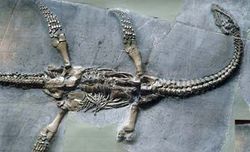
|
|---|---|
| Common Names | Plesiosaurs and pliosaurs |
| Physical Description | 1.5-15 m long, averaging 14 m. Broad and flat bodies with four airfoil-shaped flippers and short tails. The tails had flukes. The flippers were used for propulsion (the usual claim is that they moved vertically in a "flying" motion rather than in a "rowing motion"), and the tail was used for steering. The flippers were large, around as big as the body, plesiosaurs had broad bone platse on their bottoms. Plesiosauromorphs have long necks and small heads while pliosauromorphs have short necks and long heads, although these do not imply a direct relationship: some members of the Plesiosauroidea clade are short-necked, and some members of the Pliosauroidea clade are long-necked. Their necks could have up to 70 vertebrae. The skull can be described as "euryapsid." |
| Fossil Range | Late Triassic to Late Cretaceous, ~203.6-66.0 mya. Abundant during the Jurassic. Became extinct in the K-T extinction event. |
| Taxonomy | Subclass: Diapsida |
| Mode of Life or Habitat | Marine. Ate fish (piscivores). They gave birth to live young, unlike terrestrial reptiles. They may have been warm-blooded (endothermic). Plesiosaurs ate fish and cephalopods. Pliosaurs ate fish, cephalopods, sharks, ichthyosaurs, and even plesiosaurs. |
| Adaptations Over Time | Early plesiosaurs lived closer to the shore. |
| Distribution | Worldwide |
| Etymology | Their name comes from the Greek plesios meaning "near to" and sauros meaning "lizard," since they are closer to lizards than ichthyosaurs. |
| Additional Information | Have been found with gastroliths. Elasmosaurus is associated with the Pierre Shale in Kansas. It was first discovered in 1868 by Dr. Theophilus Turner and then sent to Edward Drinker Cope, who assembled the bones to form a long tail and short neck, mirroring modern lizards. This meant that the head was on the wrong end. A popular retelling has Othniel Charles Marsh, Cope's rival in the "bone wars," correcting Cope by placing it in the right place. However, it was likely actually Joseph Leidy in 1870. |
| External Links | https://en.wikipedia.org/wiki/Plesiosauria. |
Order Pterosauria (Pterosaurs)
| Picture(s) | 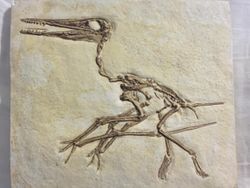
|
|---|---|
| Common Names | Pterosaurs. Pterodactyls are a subgroup of pterosaurs, genus Pterodactylus. |
| Physical Description | Some could grow up to 10-11 m and 250 kg, making them one of the biggest animals ever to fly. Some could be as small as 25 cm. Reptiles with wings made from skin and tissues going from an extended fourth finger to the ankles. They had hollow bones, a keeled breastbone, and an enlarged brain compared to its ancestors, all contributors towards the ability to fly. Many had webbed feet. Pterosaurs can be split into two groups, basal pterosaurs (also called non-pterodactyloids and rhamphorhynchus) and pterodactyloids. Basal pterosaurs were small with long tails and a wing that connected the two hind legs while pterodactyloids were more diverse and generally had narrower wings, small tails, long necks, large heads, and elongated skulls with horny beaked jaws. Pterodactyloids stood plantigrade on four limbs with their feet flat on the ground. Some pterodactyloids developed elaborate crest, displaying sexual dimorphism. Pterosaurs had pycnofibers (meaning "dense fibers") on their skin, analogous to mammalian hair, discovered by UV examination. These were about 5-7 mm long. Some speculate that pycnofibers and feathers derived from the same ancestral structure. Although in movies, pterosaurs are sometimes shown to grab prey with their feet, pterosaurs generally have no opposable toes, except for the genus Vesperopterylus, which is a small pterosaur. In Jurassic Park III, a toothless pterosaur genus was portrayed as teethed, with leathery wings instead of the more accurate taut skin membranes and an inaccurate nesting pattern. |
| Fossil Range | Late Triassic to late Cretaceous. It was once thought that birds took the place of pterosaurs, but niche overlap seems to be minimal between the two groups. |
| Taxonomy | More closely related to dinosaurs than to living reptiles. Likely evolved from archosaurs. |
| Mode of Life or Habitat | Laid eggs. Hunted by theropods (a group of three-toed saurischian dinosaurs). Lived in a variety of environments. At first, pterosaurs were seen as fish-eaters, but today, many are thought to be omnivores, carnivores, or insectivores. Basal pterosaurs were likely effective climbers and may have lived in trees, eating insects or small vertebrates. Likely warm-blooded (endothermic), as indicated by the presence of a pycnofiber coat. Difference species can be diurnal, nocturnal, or cathemeral. |
| Distribution | Worldwide. |
| Etymology | From Greek pteron "wing" + sauros "lizard." |
| Additional Information | They are the earliest vertebrates known with the ability of powered flight. Fossil eggs have been known to be found, the first of which was found in Liaoning. Baby pterosaurs are called flaplings, and it is likely that they were able to fly as soon as they hatched. Fossils are rare due to the hollow bones. Most specimens are found in Lagerstätten such as the Late Jurassic Solnhofen Limestone. Pterosaurs were first believed to be aquatic, with the wings mistaken as flippers. Found by Othniel Charles Marsh in the Niobrara Chalk in 1870, which was the first toothless specimen and whose skeletons were relatively complete, which allowed scientists to analyze the bone structure. In the late 1960s, interest in pterosaurs began to pick up again during an event known as the dinosaur renaissance, which painted dinosaurs as warm-blooded and highly active. Trace fossils show that at least some pterosaurs could run, wade, or swim. |
| External Links | https://en.wikipedia.org/wiki/Pterosaur. |
Clade Dinosauria (Dinosaurs)
| Picture(s) | No pictures have been added as of yet. |
|---|---|
| Common Names | Dinosaurs |
| Physical Description | Most dinosaurs had scaly skin with no hair. Carnivores had 2 legs, and herbivores had 4 legs. |
| Fossil Range | Evolved during the Triassic. Non-bird dinosaurs went extinct in the K-T extinction. |
| Mode of Life or Habitat | In the Triassic, they lived in riversides and scrublands. In the Jurassic, they lived in the forests. In the Cretaceous, they lived in swamplands, forests, mountains, and deserts. |
| Adaptations Over Time | Slowly shrunk and grew feathers, evolving into birds. |
| Additional Information | Interest in dinosaurs grew in the late 1960s, in a “dinosaur renaissance,” which theorized that dinosaurs were warm-blooded and therefore more active than previously imagined. |
Order Saurischia (lizard-hipped)
| Picture(s) | 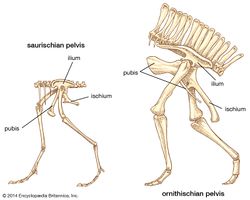
|
|---|---|
| Common Names | Lizard-hipped dinosaurs |
| Physical Description | The hips of dinosaurs are composed of the ilium, ischium, and pubis. In saurischians, the pubis is pointing forward at an angle to the ischium. This construction allowed for more surface area for muscle attachments and gave saurischians more support. Some other differences include a long neck, asymmetrical fingers, and grasping hands. |
| Fossil Range | Separated from Ornithischia in the Middle Triassic. Extant as birds, with other theropods dying out in the K-T extinction. |
| Taxonomy | The two major groups of saurischians are the sauropods (large herbivores) and the theropods (bipedal carnivores). While one might be inclined to think otherwise, birds descended from this order rather than Ornithischia. |
| Mode of Life or Habitat | All habitats. |
| Etymology | From Greek sauros "lizard" + ischion "hip joint." |
| Additional Information | The hip structure of a dinosaur can affect movement and diet. |
| External Links | https://ucmp.berkeley.edu/diapsids/saurischia/saurischia.html |
Suborder Theropoda
| Picture(s) | No pictures have been added as of yet. |
|---|---|
| Physical Description | A group of obligate bipedal (meaning they walked on two legs all the time) saurischian dinosaurs. They typically have hollow thin walled bones, as well as ziphodont (meaning serrated) teeth and claws at the end of all toes and fingers. They have an increased grasping ability and an intramandibular joint between their dentary and post dentary bones which probably acted as a shock absorber. An extra opening in the skull between the naris and the antorbital fenestra known as the promaxillary fenestra is also present in most (but not all) theropods. There are a few other distinctive traits:
|
| Fossil Range | Evolved in the Late Triassic. Extant as birds, with other theropods dying out in the K-T extinction. |
| Taxonomy | Birds descend from a clade of theropods called Coelurosauria. |
| Etymology | From Greek thiríon “beast” + poús “foot.” |
| Additional Information | Many theropods probably exhibited sexual dimorphism, typically consisting of two forms, gracile and robust. While scientists are still unsure, they believe that in most theropods the robust form (also known as a morph) represents the female, and the gracile represents the male. |
Genus Allosaurus
Genus Coelophysis
| Picture(s) | 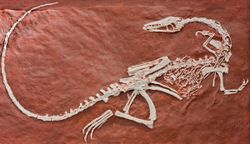
|
|---|---|
| Common Names | Coelophysis |
| Physical Description | Coelophysis is an example of an early dinosaur. They are bird-like, with light and hollow bones. They are around 3 meters long and are fast with narrow hips and feet and two long legs. Their feet and hands have 3 digits and are clawed. They have long, pointed heads. There are two forms, robust (likely the male) and gracile (likely the female). This is called sexual dimorphism. |
| Fossil Range | Late Triassic to Early Jurassic, around 216-196 mya. |
| Taxonomy | Family: Coelophysidae. There are a number of synonyms for Coelophysis, the most prominent of which is Rioarribasaurus. This is an example of a nomen rejectum (meaning "rejected name"). When paleontologists first discovered Coelophysis fossils in Ghost Ranch, they did not originally think that the fossils belonged to the genus Coelophysis. This was because they were in a much better condition than the holotype specimen. Eventually, paleontologists reclassified the fossils as belonging to Coelophysis, and as a result, the name Rioarribasaurus was retired. |
| Mode of Life or Habitat | Lived in dry savannas. It is an opportunistic carnivore, eating small reptiles and fish. It was thought that coelophysis was cannibalistic due to the discovery of what initially appeared to be juveniles in an adult's stomach. However, upon reexamination, the remains are actually of a small reptile. Paleontologists have found groups of coelophyses gathered together but are unsure if this is indicative of herd behavior or just taking advantage of a food source. |
| Distribution | Found worldwide. Most famously found in the Ghost Ranch Lagerstätte. |
| Etymology | Means "hollow form." Named by Edward Drinker Cope in 1889. |
| External Links | https://en.wikipedia.org/wiki/Coelophysis#:~:text=Coelophysis%20was%20a%20small%2C%20slenderly,Triassic%20and%20Early%20Jurassic%20formations. |
Genus Deinonychus
This specimen is not on the official 2020-2021 Fossil List but has been on the Fossil List in the past.
| Picture(s) | No pictures have been added as of yet. |
|---|---|
| Physical Description | Deinonychus has a curved, flexible neck and a big head with serrated teeth. It has three-fingered hands with sharp, curved claws. It also had a four-toed clawed foot with the second toe having a 12 cm sickle-like claw. It is around 3 m long, 1.5 m tall, and around 1 m tall at the shoulder. It has a relatively large brain (with a high EQ of around 5.8) with large, keen eyes. |
| Fossil Range | Middle Cretaceous, around 110-100 mya. |
| Taxonomy | Family: Dromaeosauridae |
| Mode of Life or Habitat | Forests. Opportunistic carnivore: ate anything it could tear apart. |
| Distribution | Western US. |
| Etymology | Means "terrible claw." |
Genus Dilophosaurus
| Picture(s) | 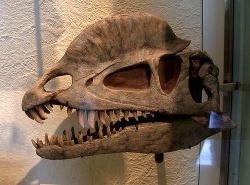
|
|---|---|
| Common Names | Dilophosaurus |
| Physical Description | This dinosaur is probably best known for the two bony crests on top of its head. These crests were elongations of the antorbital fenestra and were filled with air sacs which would have lightened and strengthened it. The crests would also likely have been covered by keratin, making them larger in life than in fossils. While famous movies (e.g. Jurassic Park) may depict them as having frills and venom, this is likely not the case. Its hand had four fingers, but the fourth finger was merely vestigial. |
| Fossil Range | Early Jurassic, around 196-183 mya. |
| Taxonomy | Family: Dilophosauridae |
| Mode of Life or Habitat | Dilophosaurus was a predator. It is thought that it may have eaten fish, as its jaw and dental structure is similar to that of a modern gharial. |
| Distribution | Known from the Kayenta Formation, in states such as Arizona, Utah, Colorado, and New Mexico. |
| Etymology | Means "two-crested lizard." Named in 1970 by Samuel P. Welles. |
| Additional Information | There have been many recent discoveries and competing theories about the use of the two crests, as well as Dilophosaurus's niche. Scientists hypothesise that the crest could have been used for mating displays as well as a way for individuals to recognize each other. Much of the confusion regarding the niche of Dilophosaurus stems from the fact that the original specimen was incomplete. More complete specimens show a robust skull as well as special ridges for muscle attachment that are present in modern day reptiles, which would increase the bite force. There is also evidence that Dilophosaurus's respiratory system allowed for unidirectional flow: this indicates that it had high metabolism levels and thus high activity levels, portraying it as a hunter rather than a scavenger. Fossils of infants, footprints, and resting traces have all been found. It is the state dinosaur of Connecticut. |
| External Links | https://en.wikipedia.org/wiki/Dilophosaurus. |
Genus Spinosaurus
This fossil will only be tested at the State and National levels.
| Picture(s) | 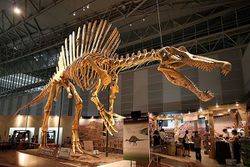
|
|---|---|
| Common Names | Spinosaurus |
| Physical Description | Spinosaurus is probably best known for the sail on its back. However, it exhibits several other less flashy yet important features. It had a long snout with unserrated teeth. Spinosaurus had three fingers and a dense bone structure. |
| Fossil Range | Late Cretaceous, 99-93.5 mya. An explanation for its extinction could be that it became much too specialized for its niche, and when its optimal environment was destroyed or when it faced competition from more generalist theropods, it would have eventually been driven to extinction. |
| Taxonomy | Family: Spinosauridae |
| Mode of Life or Habitat | Predator. Probably lived in a semi aquatic environment. |
| Adaptations Over Time | Had a long paddle like tail, indicating that it likely lived in an aquatic environment and used its tail to propel itself through water. |
| Distribution | North Africa, particularly Egypt (Bhariya Formation) and Morocco (Kem Kem Beds). |
| Etymology | Named by Ernst Stromer in 1915. Means "spine lizard." |
| Additional Information | The first specimen was only known by a few bones and was destroyed during WW2. More complete specimens were only found recently (in the 2000s). The purpose of Spinosaurus's sail is still debated, but there are a few popular theories:
|
| External Links | https://en.wikipedia.org/wiki/Spinosaurus |
Genus Tyrannosaurus
| Picture(s) | 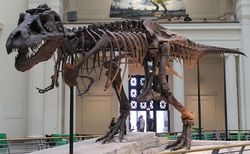
|
|---|---|
| Common Names | Tyrannosaurus |
| Physical Description | Tyrannosauruses are 12 m long and 5 m tall (4 m at the hips). They had huge skulls (1.5 m long) at the ends of short and muscular S-shaped necks and long and heavy tails as a counterbalance. The arms were short. They had two clawed fingers and a small metacarpal. Their feet are bird-like with three clawed toes and a metatarsus. Tyrannosaurus bones are hollow, like birds. Tyrannosaurus had a bite force of 35000-57000 newtons (7900-13000 lbs). There are two different morphs of tyrannosaurs, robust and gracile. These morphs suggest that tyrannosauruses exhibited some form of sexual dimorphism, with females being larger, as they needed a larger pelvis to lay eggs. Scientists think that tyrannosauruses probably had some form of primitive feathers. They also had large olfactory bulbs, which means that they had a good sense of smell. This could have been used to sniff out carcasses. There are small holes on the upper and lower jaws of the skull known as foramina. These are common in theropod dinosaurs and could indicate the presence of a sensory organ such as lips. |
| Fossil Range | Late Cretaceous, 85-65 mya. |
| Taxonomy | Family: Tyrannosauridae Some scientists classify species from the genus Tarbosaurus ("terrible lizard") as part of Tyrannosaurus. |
| Mode of Life or Habitat | It is debated whether tyrannosauruses were scavengers, active hunters, or a combination of the two. Likely fed on hadrosaurs, ceratopsians, and ankylosaurs. May have eaten Tyrannosaurus carcasses. Lived in the coastal plains of Larimidia, which was the western half of the United States, separate from Appalachia. |
| Distribution | Western North America |
| Etymology | Means "tyrant lizard." T. rex means "tyrant lizard king." Named in 1905 by Harry Osborn, although it was discovered by Barnum Brown. |
| External Links | https://en.wikipedia.org/wiki/Tyrannosaurus |
Genus Velociraptor
| Picture(s) | 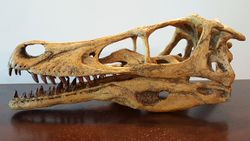
|
|---|---|
| Physical Description | Around 1.5 m long and 1 m tall, with a long, flat snout. Their head is 18 cm long, and their neck is S-shaped. They have three clawed fingers and four clawed toes. Their legs are long and thin, and they have a stiff tail containing fused bones for counterbalance. They could run 60 km/h in short bursts. Velociraptors are feathered and bipedal with an enlarged sickle shaped claw, likely used to help kill its prey. Although featured in Jurassic Park, the movie’s adaptation of velociraptors was likely based on the genus Deinonychus. The teeth and jaws of velociraptors are small and were likely unable to kill. The scleral rings (which support the eyes) have been compared to modern birds and indicate that velociraptors are probably nocturnal. |
| Fossil Range | Late Cretaceous, around 85-80 mya. |
| Taxonomy | Family: Dromaeosauridae |
| Mode of Life or Habitat | Lived in hot, dry environments with streams. There is little evidence showing that velociraptors hunted in packs. However, some of their close relatives might have. Velociraptors were probably warm blooded since they had feathers and needed a fast metabolism to be hunters. |
| Distribution | Mongolia (Barun Goyot Formation and Djadochta Formation), China, and Russia. |
| Etymology | From Latin for "swift thief." Named by Henry Fairfield Osborn in 1924. |
| Additional Information | One famous fossil involves a velociraptor fighting a protoceratops. |
| External Links | https://en.wikipedia.org/wiki/Velociraptor. |
Suborder Sauropodamorpha
| Picture(s) | No pictures have been added as of yet. |
|---|---|
| Common Names | Sauropods |
| Physical Description | Herbivorous dinosaurs characterized by small skulls, long necks, and (at least ancestrally) leaf-shaped teeth. Many of them also have a very large and strongly rotated manual digit I. Later sauropods may have even had a small fleshy cheek. Here are some other features:
|
| Fossil Range | Late Triassic to Cretaceous. |
| Mode of Life or Habitat | This is one of the rare examples where an organism evolves herbivory (this means that its ancestors were originally carnivores). Another dietary behavior some sauropods had is known as bulk browsing. This is the biting off and swallowing of large quantities of food without chewing, letting the gizzard grind them up. To facilitate this, the cheeks are lost, and a wide gape and tooth-to-tooth occlusion is evolved. This is present in gravisaurs. By comparing the scleral rings (used to support the eyes) in sauropodomorphs and modern day birds, scientists have concluded that sauropodomorphs were likely cathermal (active during the day for short intervals). |
| Etymology | Means "lizard-footed forms." Originally established by Friedrich von Huene in 1932. |
| Additional Information | The evolutionary trend of gigantism is seen in sauropodomorphs. Early sauropodomorphs are relatively normal sized while core sauropodomorphs and near sauropodomorphs were much larger (3-8 m and 10+ m respectively). Supergiants occur independently in many different genera. |
Genus Apatosaurus
This specimen is not on the official 2020-2021 Fossil List but has been on the Fossil List in the past.
| Picture(s) | No pictures have been added as of yet. |
|---|---|
| Common Names | Apatosaurus |
| Physical Description | Apatosauruses have sturdy legs, and their hind legs are larger than their forelegs. Their forelegs had 1 claw, while their hind legs had 3 claws. They have slim tails, and their vertebrae have enormous spines. Their heads and brains are relatively small. |
| Fossil Range | Late Jurassic, around 157-146 mya. |
| Taxonomy | Infraorder: Sauropoda Family: Diplodicidae |
| Distribution | North America |
| Etymology | Means "deceptive lizard," as apatosaurus bones have been mistaken for mosasaur bones. |
| Additional Information | When an Apatosaurus skeleton was put together with the head of a camarasaurus, the "new" dinosaur was mistakenly named Brontosaurus ("thunder lizard") by Othniel Charles Marsh. The mistake was soon discovered. |
Genus Brachiosaurus
| Picture(s) | 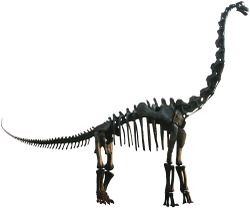
|
|---|---|
| Common Names | Brachiosaurus |
| Physical Description | Brachiosauruses were long-necked quadrupedal sauropods. Their front legs were much longer than their hind legs, and they had chisel-like teeth. They had a claw on the first toe of each front foot and claws on the first three toes of each rear foot. They also had small heads, reducing the amount of effort required to lift the head. In addition, Brachiosaurus had a complex system of air sacs to lighten its long neck. Had 52 teeth. Because of their long necks, brachiosauruses probably had an extremely high blood pressure of over 400 mmHg. |
| Fossil Range | Late Jurassic, 154-153 mya. |
| Taxonomy | Family: Brachiosauridae |
| Mode of Life or Habitat | May have been gigantothermic, meaning it was easier for brachiosauruses to maintain a constant and very high body temperature because of the small surface area to volume ratio. Estimated to have had an internal temperature of 38.2 degrees Celsius. May have travelled in herds. |
| Distribution | North America (especially the Morrison formation in the western United States) and Africa. |
| Etymology | Means "arm lizard." Named by Elmer S. Riggs in 1903. First found in the Colorado River valley. |
| Additional Information | Their size was their primary defense mechanism. Their tails could also have caused severe damage. One interesting flaw in Brachiosaurus’s body design was that if a brachiosaurus ever fell over, the impact might have killed it. They laid eggs but did not provide care. One major question about reproduction is how brachiosauruses laid eggs without breaking them. It has been proposed that they used tubes that extended from their bodies like modern-day turtles. |
| External Links | https://en.wikipedia.org/wiki/Brachiosaurus. https://en.wikipedia.org/wiki/Morrison_Formation. |
Genus Diplodocus
| Picture(s) | 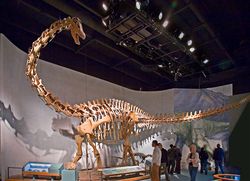
|
|---|---|
| Physical Description | Long neckedd qaudrupedal herbivorous sauropod dinosaur. Its front legs were shorter than its back legs and had a row of spines running down its back. Its nostrils were at the top of its head and it had peg-like teeth. They also had Gastralia- or hanging belly ribs- these are not actual bone rather ossified abdomen muscles. It was about 24 m long. They had an extremely long tail which had 80 vertebrae |
| Fossil Range | Mid to Late Jurassic |
| Etymology | double beamed, referring to the double-beamed chevron bones located in the underside of the tail named by Marsh - 1878 but discovered by S. W. Williston in 1877 |
| Additional Information | Stripped leaves of off branches, this behavior is shown by its outward pointed teeth and that teeth are only present in the front of the mouth. Has been called the longest dinosaur that ever lived, but that may no longer be accurate. It is easy to confuse Diplodocus with brachiosuarus, one main difference is that the hind legs of diplodocus are longer than its fore leimbs but in brachiosaurus it is the other way around. The assumption that diplodocus used its long neck to reach leaves high up is false, as this would have placed extreme pressure on their blood vessels. Instead they likely held their neck out horizontally and swung it back and forth to feeed on lower vegetation. It has also been suggested that the long neck was a mating adaptation. Diplodocus had no known predators as an adult but juveniles were likely subject to predation. Their long tails could have been used for defense or as a signalling device. May have had an ovippositor to lay eggs. Their eggs were small compared to thei size, this was probably meant to make the incubation time shorter so the eggs were less susceptible to predators. |
| External Links | https://en.wikipedia.org/wiki/Diplodocus |
Genus Patagotitan
This fossil will only be tested at the State and National levels.
| Picture(s) | 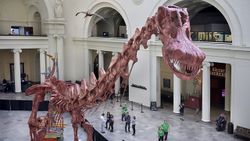
|
|---|---|
| Physical Description | A quadripedal sauropod dinosaur with a smalll head, large nostrils, and hollow bones. It could grow up to 37 m and have a mass of 55-57 tons. There are three distinguishing features of Patagotitan:
|
| Fossil Range | Late Cretaceous |
| Distribution | Argentina, Chubut Province - Cerro Barcino Formation |
| Etymology | Named after where it was found (patagonia) as well as the titans from greek mythology which symbolize strength |
| Additional Information | There is only one species in this genus: Patagotitan mayorum. Might have been the largest land animal ever. |
| External Links | https://en.wikipedia.org/wiki/Patagotitan |
Genus Plateosaurus
| Picture(s) | 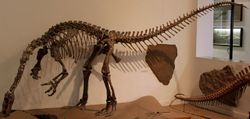
|
|---|---|
| Physical Description | Plateosaurus is a basal or early sauropod(prosauropod), this means that many behaviors/features commonly associated with sauropods are missing. It is bipedal and even though its skull is small, similar to other sauropods, its neck is not nearly as long(only 10 cervical vertebrae) it also had 40 caudal vertebrae. It has grasping hands with three fingers and large claws, possibly used for feeding or defense. Individual skulls have a large range of sizes indicating that their growth was individual, fluctuating based on resources and the surrounding environment, this is also known as developmental plasticity and is seen in many modern day reptiles. It was digitigrade, meaning it walked on its toes like cats. Its eyes were on the side of its hea to enable a greater field of vision to watch for predators. The resperatory system was an important discovery for scientists. It was found that plateosaurus had a respiratory system similar to birds where air sacs push into the bone to decrease weight (also known as postcranial pneumaticity). This is the adaptation that allowed later sauropods to grow so large. An important feature Plateosaurus shares with other sauropods is its crowned teeth, meant to feed on plants. |
| Fossil Range | late Triassic |
| Taxonomy | Chordata, Reptilia, Dinosauria, Saurischia, Sauropodomorpha, Plateosauridae |
| Distribution | Europe, North America, Greenland - Fleming Fjord Formation. |
| Etymology | Described by Christian Erich Hermann von Meyer - 1837, discovered in 1834 by Johann Friedrich Engelhardt name means broad lizard |
| Additional Information | Was capable of walking quadrepedally, for a slow gate, and bipedally for a faster gate. Unlike mammals when Plateosaurus wanted to move faster it relied on either lengthening its stride. The growth of plateosaurus is also unusual. It continued to grow even after sexual maturity, and only stopped when it reached its maximum size, this is known as determinate growth. Were probably cathermal, active for short periods of time during the day and night, and endothermic (from the microstructure in the bones). |
| External Links | https://www.ncbi.nlm.nih.gov/pmc/articles/PMC4103078/ https://en.wikipedia.org/wiki/Plateosaurus |
Order Ornithischia (bird-hipped)
| Picture(s) | No pictures have been added as of yet. |
|---|---|
| Physical Description | Ornithischia is an order of dinosaurs classified by the orientation of their hip bones. In Ornithischian dinosaurs the structure resembles that of modern birds-- but be careful as this does not mean that birds evolved from ornithischian dinosaurs. In ornithischians the pubis bone is parallel to the ischium, this arragnement provided more room for the intset\stines, an important feature in herbivorous dinosaurs. In addition, Ornithisians had a wider pelvis, for more stability, a smaller antorbital fenestra (opening in the skull), and were for the most part herbivores. |
| Etymology | "bird-hipped"- Harry Seeley 1887 |
| External Links | https://en.wikipedia.org/wiki/Ornithischia https://www.theatlantic.com/science/archive/2017/03/dinosaur-family-tree-saurischia-ornithischia-childhood-shattered-what-is-real-anymore/520338/ |
Infraorder Anklyosauria
| Picture(s) | No pictures have been added as of yet. |
|---|---|
| Physical Description | Ankylosaurs are more focused on passive defense adaptions than other armored dinosaurs, like stegasaurs. They are characterized by Osteoderms, or scutes, fused to the skull roof, osteoderms covering the neck and shoulders as well as extensively covering their backs, and for being wider than they were tall (an unusual construction in dinosaurs). |
| Fossil Range | First appear in the jurassic but are rare, become much more common during the cretaceous |
| Adaptations Over Time | They could breathe while chewing. Reduced predentary bone allowed them to more efficiently chew their food, this is an example of convergent evolution as it also appears in other ornithopods. Ankylosaurs also had strong, specialized tongues. |
| Etymology | named by Osborn in 1923. |
| Additional Information | The most famous feature of Ankylosaurs is their osteoderms, which are similar to modern day crocodiles. These osteoderms were composed of a thin outer layer of compat bone and were filled with spongy bone.They may have also been covered in keratin, which does not fossilize well. |
Genus Ankylosaurus
Infraorder Ceratopsia
| Picture(s) | No pictures have been added as of yet. |
|---|
Genus Triceratops
Genus Protoceratops
This fossil will only be tested at the State and National levels.
Infraorder Ornithopoda
| Picture(s) | No pictures have been added as of yet. |
|---|
Genus Iguanodon
| Picture(s) | 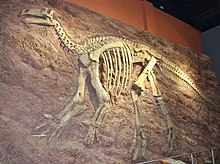
|
|---|---|
| Physical Description | Iguanodon was a large herbivore that was able to shift between bipedal and quadrupedal stances. On average, Iguanodon was 10 meters long and weighed about 3 tons. They had beaked mouths and their thumbe were composed of a modified claw, likely used for protection or foraging. The fifth digit(the pinkie) was extremely flexible, one possible purpose of this finger was to grasp branches. The middle three digits were inflexible and were meant to bear most of the weight. |
| Fossil Range | mid Jurassic to Early Cretaceous |
| Taxonomy | Animalia, Chordata, Reptilia, Dinosauria, Ornithischia, Ornithopoda, iguanodontidae, Iguanodon |
| Mode of Life or Habitat | Herbivore |
| Etymology | Named by Gideon Mantell - 1825, Discovered by William Harding Bensted, means 'iguana-tooth' |
| Additional Information | In early reconstructions the Iguanodon's thumb spike was placed on its snout. In addition, these reconstructions depicted Iguanodon as a tail dragger. In reality, this would not have been anatomically possible because the tails of Iguanodon were made of ossified bones-- bones that turned to bone during development-- and would have had to be held horizontally. |
| External Links | https://en.wikipedia.org/wiki/Iguanodon#Description |
Genus Parasaurolophus
| Picture(s) | 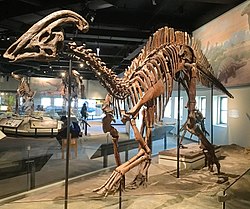
|
|---|---|
| Physical Description | Parasaurolophus was a herbivore dinosaur that was both biped and quadruped. One of the most striking features is its crest. The average weight is 2.5 tons and the estimated length 9.5 m. They exhibit sexual dimorphism, which is shown in their crest size. |
| Fossil Range | Late Cretaceous |
| Taxonomy | Animalia, Chordata, Reptilia, Dinosauria, Ornithischia, Hadrosauridae, Lambeosaurinae |
| Adaptations Over Time | There are many theories about the purpose of the crest, however many have been debunked. The most popular ones include:
Its jaws were well suited for chewing pine cones and pine needles. |
| Distribution | Have been found in the Fruitland Formation of New Mexico and the Dinosaur Park Formation in Alberta |
| Etymology | meaning "near crested lizard" in reference to another dinosaur, Saurolophus. Named By William Parks - 1922. |
| External Links | https://en.wikipedia.org/wiki/Parasaurolophus |
Genus Maiasaura
Infraorder Pachycephalosauria
| Picture(s) | No pictures have been added as of yet. |
|---|
Genus Dracorex
Infraorder Stegosauria
| Picture(s) | No pictures have been added as of yet. |
|---|
Genus Stegosaurus
| Picture(s) | 
|
|---|---|
| Physical Description | Stegasaurus was a quadrupedal herbivorous dinosaur with a line of dermal plates running down its back, also referred to as osteoderms. Stegasaurus aslo had spikes on its tail, which are known as the thagomizer and were likely used for defense. Its forelimbs were shorter than its hind limbs, as a result it was slow and its tail was probably held at an upward angle. Could be 9 m in length and 5-7 tons. They had no teeth at the front of their mouths, instead, a beak to help them graze on vegetation. |
| Fossil Range | Late Jurassic |
| Taxonomy | Kingdom: Animalia, Phylum: Chordata, Class: Reptilia, Order: Ornithischia, Family: Stegosauridae |
| Adaptations Over Time | There were between 17-22 plates on Stegasaurus' back they were probably covered in a keratenous sheath. Their purpose is still debated some theories include:
|
| Distribution | Morrison Formation. Portugal - Alcobaça Formation |
| Etymology | First described by Marsh in 1877 during the Bone Wars. Means 'roof lizard' in Greek, it was called this because Marsh originally believed the bones veolnged to a turtle. |
| Additional Information | IT has taken scientists a while to settle on the current plate formation which hs two rows of alternating plates. Stegasaurus is known for having an extremely small brain, often described as the size of a walnut. At one point paleontologists believed that Stegasaurus had a second brain next to its hip. This region, known as the sacro-lumbar expansion, is present in birds and actually contains something know as the glycogen body. |
| External Links | https://en.wikipedia.org/wiki/Stegosaurus |
Class Aves (Birds)
| Picture(s) | No pictures have been added as of yet. |
|---|
Genus Archaeopteryx
Genus Titanis (Terror Bird)
Genus Icthyornis
This fossil will only be tested at the State and National levels.
Clade Synapsida
| Picture(s) | No pictures have been added as of yet. |
|---|
Mammal-like Reptiles
| Picture(s) | No pictures have been added as of yet. |
|---|
Genus Dimetrodon (pelycosaurs)
Genus Lystrosaurus (therapsids)
Class Mammalia (Mammals)
| Picture(s) | 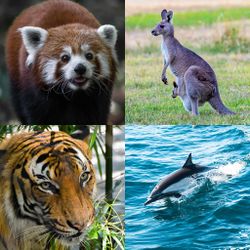
|
|---|
Genus Basilosaurus (prehistoric whale)
Genus Equus (modern horse)
Genus Australopithecus (hominin)
This fossil will only be tested at the State and National levels.
Genus Homo (hominin)
| Picture(s) | 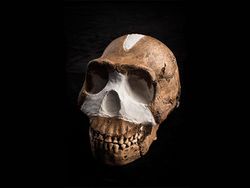
|
|---|
Species H. neanderthalensis
Species H. erectus
This fossil will only be tested at the State and National levels.
| Picture(s) | 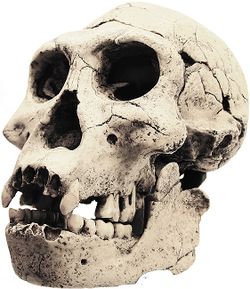
|
|---|
Species H. sapiens
| Picture(s) | 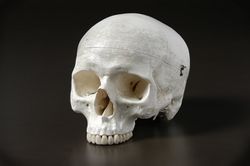
|
|---|


